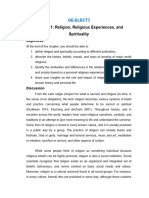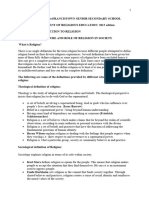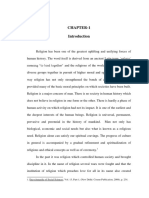0 ratings0% found this document useful (0 votes)
3 viewsReligion
Religion
Uploaded by
gclaudenejoyThe document discusses the fundamental features of religion which include cosmological, soteriological, anthropological, symbolic, moral, organizational, and theological aspects. Cosmological features provide explanations for the universe's origins and order. Soteriological aspects relate to salvation from evil. Anthropological features examine human nature and redemption. Symbolic and ritual components use symbols and acts to communicate religious truths.
Copyright:
© All Rights Reserved
Available Formats
Download as DOCX, PDF, TXT or read online from Scribd
Religion
Religion
Uploaded by
gclaudenejoy0 ratings0% found this document useful (0 votes)
3 views3 pagesThe document discusses the fundamental features of religion which include cosmological, soteriological, anthropological, symbolic, moral, organizational, and theological aspects. Cosmological features provide explanations for the universe's origins and order. Soteriological aspects relate to salvation from evil. Anthropological features examine human nature and redemption. Symbolic and ritual components use symbols and acts to communicate religious truths.
Original Title
religion
Copyright
© © All Rights Reserved
Available Formats
DOCX, PDF, TXT or read online from Scribd
Share this document
Did you find this document useful?
Is this content inappropriate?
The document discusses the fundamental features of religion which include cosmological, soteriological, anthropological, symbolic, moral, organizational, and theological aspects. Cosmological features provide explanations for the universe's origins and order. Soteriological aspects relate to salvation from evil. Anthropological features examine human nature and redemption. Symbolic and ritual components use symbols and acts to communicate religious truths.
Copyright:
© All Rights Reserved
Available Formats
Download as DOCX, PDF, TXT or read online from Scribd
Download as docx, pdf, or txt
0 ratings0% found this document useful (0 votes)
3 views3 pagesReligion
Religion
Uploaded by
gclaudenejoyThe document discusses the fundamental features of religion which include cosmological, soteriological, anthropological, symbolic, moral, organizational, and theological aspects. Cosmological features provide explanations for the universe's origins and order. Soteriological aspects relate to salvation from evil. Anthropological features examine human nature and redemption. Symbolic and ritual components use symbols and acts to communicate religious truths.
Copyright:
© All Rights Reserved
Available Formats
Download as DOCX, PDF, TXT or read online from Scribd
Download as docx, pdf, or txt
You are on page 1of 3
Fundamental Features of Religion
I. COSMOLOGICAL
The scientific study of the structure, composition, and development of the
physical cosmos is known as cosmology. Religious cosmologies offer "big
picture" explanations for the origins of human life as well as an understanding of
the forces and powers that shape the universe. Belief in the supernatural, a world
beyond of direct human experience, is a second aspect of religion. Religious
cosmologies provide explanations for the universe's creation as well as the laws or
"order" that control reality. A cosmology may be defined as an origin narrative in
its most basic form. It provides an explanation for the world's past, present, and
potential futures as well as the ancestry of the humans, spirits, divinities, and other
entities that inhabit it.
II. SOTERIOLOGICAL
The area of theology known as soteriology is devoted to the study of
salvation. The phrase is connected to various other disciplines of theology in that
it questions who is saved, by whom, from what, and by what means. It originates
from the Greek soterion, "salvation," and is also related to soter, "savior."
According to academics, soteriology refers to a central principle found in many
different faiths and is frequently examined in the framework of comparative
studies, which compares distinct understandings of what salvation is and how it
could possibly be attained. Whether it be in this world, the next, or maybe both,
most religions are equally concerned with achieving a state of blessedness,
release, or satisfaction that surpasses evil. One of the basic tenets of post-archaic
religion is salvation.
III. ANTHROPOLOGICAL
The study of anthropology focuses on the emergence and evolution of
human civilizations and cultures. A person's acquired behavior encompasses their
language, social structures, institutions, material possessions, and, most
importantly, their belief systems. This is known as their culture. Since many
religious systems (such as Buddhism, Hinduism, and Christianity) explain the
issue of evil and how followers attempt to escape it, this component of religion is
entwined with the soteriological side. According to traditional Christianity, sin is a
part of who we are as people. This idea lays the groundwork for redemption via
divine grace, which results from God's sin forgiveness. Buddhism holds that
human suffering is ingrained in the human mind and that redemption by
intellectual development is possible. Therefore, the notion of human nature, the
issue of evil, and the means of redemption are intertwined in all religions.
IV. SYMBOLIC
Some academics of mythology and psychology even go so far as to say
that the primary feature of religious expression is its symbolic component. One of
the most significant ways to understand and communicate religious truths is
thought to be through systems of symbols and images that are composed in a
certain organized and specified connection to the form, substance, and goal of
presentation. Acts take on significance when they are motivated by religion.
Religion is manifested in public through rituals. Ritual includes the following: 1)
the social structure of the religious community; 2) the roles of different religious
personnel designated for specific religious responsibilities; 3) the ways in which
followers approach the sacred dimension through behavior; and 4) the
mechanisms employed to ensure appropriate behavior both in groups and on an
individual basis. Furthermore, ritual acts are frequently regarded as sacred, or seen
as essential to achieving salvation. This prompts an examination of three topics:
1) the use of symbols in religion; 2) distinctive gestures, speech patterns, and
bodily movements; and 3) the impact of religious belief on art and architecture.
V. MORAL
While religion focuses largely on the interaction between humans and a
transcendent reality, morality is regarded to relate to the conduct of human affairs
and relations between individuals. Though he was willing to criticize religious
excesses and fanaticism, Kant's thinking embodied the views of those who felt
that morality and religion are mutually exclusive. He was convinced that belief in
a God who rewards the virtuous and punishes the wicked was necessary to ensure
full moral commitment.
VI. ORGANIZATIONAL
In society, supportive organizations play a crucial role. They were created
to support those who are experiencing difficulties. Although religious views might
be very personal, religion is also a social institution, despite the fact that some
individuals consider religion to be something personal. According to social
scientists, religion is an integrated and structured system of rules, actions, and
beliefs that are based on fundamental societal needs and values. Numerous
religious organizations fulfill this purpose, as do interfaith organizations that unite
followers of various religions in order to assist the underprivileged. Religious
organizations are nonprofit, voluntary, registered, or unregistered enterprises
whose purpose and identity are drawn from a religious or spiritual tradition.
VII. THEOLOGICAL
The study of religion is called theology. It looks at how religion manifests
itself in various human experiences and cultural contexts. The essence of the
ultimate being, or whatever serves as the foundation of ultimate validity in
religion, is the subject of theology. Gods are primarily thought of as concepts or
imaginary beings to be studied with intellectual curiosity; they are the subjects of
religious activity and devotion. Understanding a certain religious perspective
necessitates understanding and appreciating how its followers connect their
practices and beliefs to extremely significant entities. In order to adequately
address theology, one must examine how believers see their relationship to the
objects of their devotion as well as the philosophical frameworks that articulate
this relationship.
References:
Stetler, E. (2014). Soteriology. In Springer eBooks (pp. 1688–1689). https://doi.org/10.1007/978-1-
4614-6086-2_654
Wiki, C. T. R. (n.d.). Soteriology. Religion Wiki. https://religion.fandom.com/wiki/Soteriology
Anthropology of Religion | Encyclopedia.com. (n.d.). https://www.encyclopedia.com/philosophy-and-
religion/other-religious-beliefs-and-general-terms/religion-general/anthropology-religion
Goldammer, K. M. A. (1999, July 26). Religious symbolism and iconography | Description, Meaning,
Types, Influence, & Facts. Encyclopedia Britannica.
https://www.britannica.com/topic/religious-symbolism
Morality and Religion | Encyclopedia.com. (n.d.).
https://www.encyclopedia.com/environment/encyclopedias-almanacs-transcripts-and-maps/
morality-and-religion
Library Guides: Theology and Religion: Background information. (n.d.).
https://libguides.library.nd.edu/theology-and-religion
Libretexts. (2021, July 23). 10.3: Elements of Religion - Cosmologies and the Supernatural. Social
Sci LibreTexts. http://tinyurl.com/5b3zp2yn
You might also like
- AASR 1946 RitualBookDocument201 pagesAASR 1946 RitualBookAmacroyal90% (42)
- Dreams and Their Meanings by DR D K OlukoyaDocument15 pagesDreams and Their Meanings by DR D K OlukoyaJardel Artur100% (7)
- Kalidasa ShakuntalaDocument94 pagesKalidasa Shakuntalaapi-373040571% (7)
- Mauri Vatican RatlineDocument152 pagesMauri Vatican RatlineBorisSub100% (8)
- Religious Education For TavongaDocument102 pagesReligious Education For TavongaTlotlo carvin NthokgoNo ratings yet
- Religion and Belief System - UCSP-11Document11 pagesReligion and Belief System - UCSP-11Rosemarie Deapera100% (2)
- Comparative Study of ReligionDocument18 pagesComparative Study of ReligionJunior MirandaNo ratings yet
- ReligionDocument5 pagesReligionmichelmalaqui100% (3)
- Spiritual Baptist SongDocument8 pagesSpiritual Baptist SongAndrew Adams100% (2)
- Influences of ReligionDocument4 pagesInfluences of ReligionRia LucenaNo ratings yet
- Religion Early FormsDocument20 pagesReligion Early FormsKuru SscNo ratings yet
- Lecture 11Document35 pagesLecture 11AbdirahmanNo ratings yet
- Objectives: LESSON 1 - Influences of Religion To Culture and SocietyDocument16 pagesObjectives: LESSON 1 - Influences of Religion To Culture and SocietyPrinces SomeraNo ratings yet
- Religion - Anthro1 PDFDocument59 pagesReligion - Anthro1 PDFGargi UpadhyayaNo ratings yet
- Functions of Religious InsitutionsDocument16 pagesFunctions of Religious InsitutionsTaeyong LeeNo ratings yet
- Religion, Economy, PoliticsDocument13 pagesReligion, Economy, Politicshunaiza khanNo ratings yet
- Sociology DADocument21 pagesSociology DAemilylizgNo ratings yet
- Worldview and CultureDocument11 pagesWorldview and Culturehimi oumaimaNo ratings yet
- Rres Module 1 - Lesson 1Document3 pagesRres Module 1 - Lesson 1Ella BrionesNo ratings yet
- Module 1 GE Elect 3Document25 pagesModule 1 GE Elect 3mallarialdrain03No ratings yet
- Ignou Books Tanqeed o BalaghatDocument10 pagesIgnou Books Tanqeed o BalaghatLOCAL VILLAGERNo ratings yet
- Understanding ReligionDocument10 pagesUnderstanding Religionelie lucidoNo ratings yet
- Religious Education NotesDocument101 pagesReligious Education NotestsholofelobapingNo ratings yet
- Religious Education Notes-1Document100 pagesReligious Education Notes-1palesambalie828No ratings yet
- Religious Education Notes-1Document100 pagesReligious Education Notes-1hardenhardlessNo ratings yet
- Fifth EditionDocument94 pagesFifth EditionkatkaisaraNo ratings yet
- PhilosophyDocument6 pagesPhilosophyTaiba ShahNo ratings yet
- Introduction To World Religions and Belief SystemDocument41 pagesIntroduction To World Religions and Belief Systemkenethdalilis0No ratings yet
- Week1 4 Intro To RelDocument11 pagesWeek1 4 Intro To RelMark Stephen ReditoNo ratings yet
- Lesson 19-UcspDocument8 pagesLesson 19-Ucspjeniver esguerraNo ratings yet
- Religion and Society NotesDocument7 pagesReligion and Society NotesWesley100% (1)
- Theology 110 Presentation of IdeasDocument7 pagesTheology 110 Presentation of IdeasTater ToataNo ratings yet
- Exploring Religion: A Comprehensive Guide to Understanding FaithFrom EverandExploring Religion: A Comprehensive Guide to Understanding FaithNo ratings yet
- SOC614 HandoutsDocument195 pagesSOC614 HandoutsasadNo ratings yet
- Module 3 - Understanding Culture, Society and PoliticsDocument7 pagesModule 3 - Understanding Culture, Society and PoliticsHelenNo ratings yet
- Philosophy of ReligionDocument6 pagesPhilosophy of ReligionMujalin MinmookdaNo ratings yet
- 9 - WorldviewDocument13 pages9 - WorldviewShiv ParmarNo ratings yet
- Introduction To World Religions Q1-M1Document19 pagesIntroduction To World Religions Q1-M1Kian Arthur AngcosNo ratings yet
- UCSP PRESENTATION LorenDocument11 pagesUCSP PRESENTATION LorenMitchiko MondoyNo ratings yet
- Introduction TDocument26 pagesIntroduction Tmiguelsugian20No ratings yet
- Ucsp Topic 25 ReligionDocument4 pagesUcsp Topic 25 ReligionLiza EmmanuelleNo ratings yet
- RELIGIONDocument5 pagesRELIGIONpham khangNo ratings yet
- G11&12 - Intro To World Religion & Belief System - Q1 - W1-7Document75 pagesG11&12 - Intro To World Religion & Belief System - Q1 - W1-7John Laverne Capalis BocadoNo ratings yet
- Chapter 1: Introduction To Religions, Religious Experiences and SpiritualityDocument7 pagesChapter 1: Introduction To Religions, Religious Experiences and SpiritualityJustine Inocando100% (2)
- World Religions and Belief Systems HandoutsDocument12 pagesWorld Religions and Belief Systems HandoutsMaRvz Nonat Montelibano100% (1)
- Social AnthropologyDocument17 pagesSocial AnthropologySampat PrajapatiNo ratings yet
- ReligionDocument10 pagesReligionezeobichidera08No ratings yet
- World ReligionDocument9 pagesWorld ReligionRodelyn Ramos GonzalesNo ratings yet
- g11 Gas Wrbs Gbs For Week 21 To Week 23 r632077Document11 pagesg11 Gas Wrbs Gbs For Week 21 To Week 23 r632077SIMON CHRISTOPHER ARADANo ratings yet
- Grade 11 IntroDocument11 pagesGrade 11 IntroMaria Theresa Tutor EscalonaNo ratings yet
- Chapter 1 in Iwrbs 2Document58 pagesChapter 1 in Iwrbs 2Marcus Abracosa CaraigNo ratings yet
- Module 1Document11 pagesModule 1Victor Noel AlamisNo ratings yet
- Unit 3Document13 pagesUnit 3Rishendri -No ratings yet
- Nature of Re DefinitionsDocument10 pagesNature of Re Definitionsapi-247725573No ratings yet
- Karmic and Abrahamic Faiths: Comparative Themes for Interreligious DialogueFrom EverandKarmic and Abrahamic Faiths: Comparative Themes for Interreligious DialogueNo ratings yet
- BCS Lecture Note - Major ReligionDocument63 pagesBCS Lecture Note - Major ReligionmengreiaNo ratings yet
- UCSP Written ReportDocument7 pagesUCSP Written ReportBujorge BuboyNo ratings yet
- Local Media4758723238205147632Document66 pagesLocal Media4758723238205147632Reymar LaganosaNo ratings yet
- Itwrl 1 4Document5 pagesItwrl 1 4bautistalheon95No ratings yet
- IWRBS Calibrated Q1 Week 1Document3 pagesIWRBS Calibrated Q1 Week 1Liezel Mae ViodorNo ratings yet
- Defining ReligionDocument8 pagesDefining ReligionMichael OwojuyigbeNo ratings yet
- Religionandbeliefsystemscoleennoquiz 171003233222Document50 pagesReligionandbeliefsystemscoleennoquiz 171003233222yuan salayogNo ratings yet
- Ucsp Handouts Religion - HealthDocument11 pagesUcsp Handouts Religion - HealthChristopher Flor de LisNo ratings yet
- Unit 1Document11 pagesUnit 1SSANo ratings yet
- 05 Chapter 1Document68 pages05 Chapter 1BhagirathNo ratings yet
- Permanent Injunction Against The Lisa McPherson TrustDocument18 pagesPermanent Injunction Against The Lisa McPherson TrustTony OrtegaNo ratings yet
- Alija Izetbegovic - Islam Between East and West - New Reflections (Notes From Prison Book 5) - Claritas Books (2022)Document112 pagesAlija Izetbegovic - Islam Between East and West - New Reflections (Notes From Prison Book 5) - Claritas Books (2022)Na WalNo ratings yet
- Israel, The-Church and The Last DaysDocument272 pagesIsrael, The-Church and The Last DaysPablo RiosNo ratings yet
- The Mission of Adventism The Significance of The Three Angels Messages For TodayDocument7 pagesThe Mission of Adventism The Significance of The Three Angels Messages For TodayPHED MizoramNo ratings yet
- William Kumuyi - WikipediaDocument16 pagesWilliam Kumuyi - WikipediaPeter OnojaNo ratings yet
- For The Hell of It (Razing Hell Book 1) (Cate Corvin (Corvin, Cate) ) (Z-Library)Document281 pagesFor The Hell of It (Razing Hell Book 1) (Cate Corvin (Corvin, Cate) ) (Z-Library)IsadoraNo ratings yet
- Global Bingo - ActivityDocument3 pagesGlobal Bingo - ActivityWorld Vision ResourcesNo ratings yet
- His Shoulder: and His Name Shall Be Called Wonderful, Counselor, The Mighty God, TheDocument21 pagesHis Shoulder: and His Name Shall Be Called Wonderful, Counselor, The Mighty God, TheYannick MayengaNo ratings yet
- (2024.02.04) Feast of San Pedro BautistaDocument3 pages(2024.02.04) Feast of San Pedro BautistaChristian Luis De GuzmanNo ratings yet
- El Kanah-The Jealous GodDocument12 pagesEl Kanah-The Jealous Godspeliopoulos100% (1)
- Romeo and Juliet Act 4 Scene 1Document5 pagesRomeo and Juliet Act 4 Scene 1nobodyknows1856No ratings yet
- Religion Ethics S3 SBDocument203 pagesReligion Ethics S3 SBashrafsmith272No ratings yet
- Pre Cession of The EquinoxesDocument2 pagesPre Cession of The EquinoxesJoshua WilliamsNo ratings yet
- Spirituality of Social TransformationDocument63 pagesSpirituality of Social Transformationapi-19474981100% (1)
- How Can I Pray Web PDFDocument32 pagesHow Can I Pray Web PDFIvanNo ratings yet
- Histroy of The Councils Vol 1 To Ad 325Document536 pagesHistroy of The Councils Vol 1 To Ad 325Israel100% (5)
- Orden Misa 15Document6 pagesOrden Misa 15ruth melendezNo ratings yet
- A Feminilidade Da Serpente: Subversão, Simbologia e Sugestão No Contexto FiinissecularDocument24 pagesA Feminilidade Da Serpente: Subversão, Simbologia e Sugestão No Contexto FiinissecularalineNo ratings yet
- The Power To Change Audiobook PDFDocument50 pagesThe Power To Change Audiobook PDFvictor solorzanoNo ratings yet
- Beginning Angel Magic: The Angelic HierarchiesDocument13 pagesBeginning Angel Magic: The Angelic HierarchiessKianNo ratings yet
- Contemporary "Witchdemonology" in The Church of Pentecost: 1988-2000Document2 pagesContemporary "Witchdemonology" in The Church of Pentecost: 1988-2000Nathan MwewaNo ratings yet
- Come Unto Jesus Chord ChartDocument4 pagesCome Unto Jesus Chord ChartChikaNo ratings yet
- V 7-LIBROFS USA WEBDocument356 pagesV 7-LIBROFS USA WEBMar�a Alejandra Aguja MaulhardtNo ratings yet
- Karai Kasang Shaga La Ai Hte Lata La Ai LamDocument4 pagesKarai Kasang Shaga La Ai Hte Lata La Ai LamawngNo ratings yet
- Unit 3 SHEG Lesson GALILEODocument9 pagesUnit 3 SHEG Lesson GALILEOGabriel ZapataNo ratings yet

























































































